Woburn Sands and Aspley Heath War Casualties – The 1914-1918 War
Most families from this tight knit community would have been affected in some way by the loss of a relative or friend in the Great War. The Victorian years had been kind to Woburn Sands and Aspley Heath. It’s reputation as an inland health resort had brought in thousands of visitors, all of whom needed all manner of services, which the local businesses supplied. The range of shops was second to none in the district, while the area was self-contained enough for most local people to know the details of everyone else’s lives. It still had something of a resort atmosphere when the stark reality of war was brought home to the district in late 1914 by the letters from serving soldiers to their families, (which were reprinted in the local papers) and the stories brought back by soldiers on leave, or home recuperating from injuries. Hector Newman, a wounded local man who was on his way back from the front line to hospital in Lancashire, even threw a letter out of the train as it passed through Bletchley Station, marked, “Soldiers letter, will finder kindly post.” (Bedfordshire Archives and Records Service: Z251/181) Of course, the finder did!
It was noted in the local paper, “The Woburn Reporter”, that by September 4th 1914, about 30 to 40 local men had joined the Regulars or enlisted, and some were already overseas. In July 1915, the paper reported that of ex-Aspley Heath School scholars alone, 18 were in the army at the start of the war, 62 had joined up since, nine had been refused by the army and three had already been killed. It was noted in 1916 that every member of the local football team, “The Stars”, had long since joined up and gone off to fight, and that three of them had already died. The team had won their division of the local Bedfordshire Second League in 1912, and the celebrations in The Square had lasted to midnight, with the landlord of “The Swan” filling the cup with port, many times over, for the players.
Many people would have remembered the Rev. Edward Henry Mosse, who was at St. Michaels from 1884 to 1899, before he moved on to St. Pauls in Covent Garden, London. In January 1918, aged 70, he left a bomb shelter in an air-raid to search for three lost children. After finding and reuniting them with their mother, he went back out again to tend to the elderly and was killed by a collapsing building.
More realities of the war were brought home to the villagers by the arrival of prisoners of war. In one instance, about 200 Germans were marched up the High Street under armed guard to a camp in the Duke of Bedford’s estate. This proved quite a spectacle and locals turned out in force to see them. Once at the camp, they were put to work lumbering, making trench pit props for the Front. A photo of the march and a description of the events have survived. (BLARS Z887/1-2) The Germans were not the only ones logging in Woburn Sands, as the 125th Canadian Forestry Corps. were also stationed here, and several marriages between them and the local girls followed, pre-dating the G. I. “invasion” of England in the Second World War.
Plans for a fitting memorial to those local men who had died in the war were started early in 1919. A meeting was held on 27th January, chaired by the Rev. Shelton of St. Michaels. About 70 villagers attended. The first idea was to extend St. Michaels, but this proposition was deferred for two months. In the meantime, on 22nd February, the ‘Woburn Reporter’ printed that a new church tower and a peel of bells was unfeasible due to the cost. A statue, fountain or clock in The Square, a new Recreation ground or a new Parish Institute were to be considered instead. At the next meeting, someone suggested swimming baths, along with a YMCA hut.
By 11th March, St. Michaels had decided to start their own memorial, by converting the church into a Memorial Chapel, with an entrance on the west side, but an idea for a stained glass window had been discounted, again due to cost.
For the town Memorial, £220 had already been promised by June, with the erection of a clock tower in The Square becoming the favoured option. It was budgeted to cost £260, and had been agreed by the organising committee and the order already sent in. Later in June, a list of 40 names was being displayed in the Post Office window, along with plans of the tower, for villagers to comment on and add any names that had not yet been put forward.
It appears that there was at least one alternative design. A drawing of ‘Woburn Sands Memorial Clock Tower’ by Walter B. Stonebridge, (BARS: Z569/4) shows a tower, about 25ft high, capped with a dome and a weathercock. How any traffic would have coped with such a large Memorial, and how it would have been fitted into The Square is not recorded!
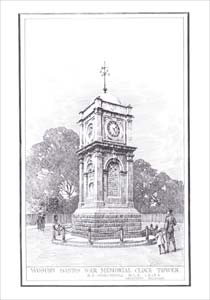
By August, only £30 still needed to be collected, but an open air fete at Dr Holmes house, ‘The Shrubbery’, in Station Road, had to be abandoned due to bad weather. Collecting seems to have slowed up, as at the end of October, the appeal was still £30 short of the target.
Eventually, the funds were raised and Messrs. Kelly and Co. of Marylebone were engaged to do the building work, under the supervision of local builder, Cyril Hutton. It was to be of Portland stone, with two clock faces surmounted by an Oxford Cross. The clock mechanism came from Gillet and Johnson of Croydon. The total cost had reached £280. In all, 43 names were inscribed on the tablet to be affixed to the side. The lamppost had to be moved from its position in the Square, and also the water trough, which had been supplied by ‘The Metropolitan Cattle Trough Association’.
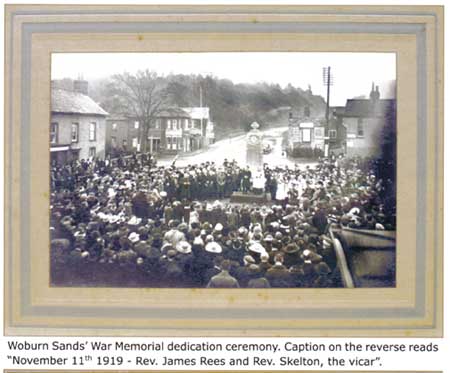
The local Methodists were in the process of dedicating their own memorial. It was resolved at their meeting of 2nd February 1920, that the secretary get the particulars of ‘..all their fallen lads’ and erect a memorial on the church premises. In May, designs for the memorial were laid before the Trustees, who chose the one they liked. The Rev. Rees and F. Day were asked to write the wording for it, and to get estimates for the cost, and an appeal was started to raise the necessary funds. The next mention in their minutes is that of 11th November 1921, when £0.17s was paid for the Memorial tablet to be erected. It is on the north wall, inside the chapel. It records the names: T. Bowler, F. Capp, P. Davies, H. Day, H. Dolton, J. Elliot, W. Smith and W. Wilson.
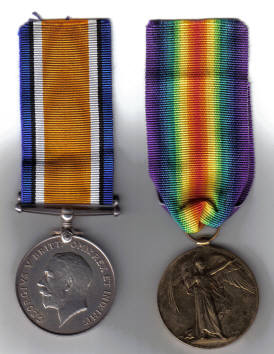
Other First World War casualties connected with Woburn Sands
According to the Commonwealth War Graves Commission and the “Soldiers Died in the Great War” index, there were other men connected with Woburn Sands and Aspley Heath, who are not listed on the Memorial. Some of these had parents or wives in the town, others were schooled here. Perhaps some families had moved away before the end of the War. Some appear on other memorials, both locally and further afield.
RIFLEMAN GERALD BRANSON, No. 474105 of the London Regiment (The Rangers), 12th Battalion. Died 23rd December 1917.
Gerald was the son of Charles William and Jane Branson, of Wood Street, Woburn Sands. He was 23. Born at Woodstone (Woolstone?), and enlisted at Northampton. He resided in Bedford. There was fierce fighting in Jerusalem during December 1917, and it was recaptured from the Turks. Recorded on the Jerusalem Memorial and Bedford St Leonards.
STOKER (1ST CLASS) FREDERICK CYRIL BRAWN, No. K/12485, HMS Triumph. Died 25th May 1915.
Son of Frederick and Elizabeth Brawn, of Aspley Heath, Woburn Sands, Beds. Aged 22. Appears on the Chatham Naval Memorial. HMS Triumph was a Swiftsure-class battleship. On 25th May 1915, Triumph was underway off Gaba Tepe, in the Dardanelles, firing on Ottoman positions, with torpedo nets out, guns manned, and most watertight doors shut, when she sighted a submarine periscope 370m off her starboard beam at about 1230 hours. All watertight doors were shut, and she opened fire on the periscope, but almost immediately took a torpedo hit on her starboard side, the torpedo slicing through her torpedo nets with ease. A tremendous explosion resulted, and Triumph listed 10 degrees to starboard. She held that list for about five minutes, then her list increased to 30 degrees. Destroyer HMS Chelmer got most of her crew off before she capsized ten minutes later. She remained afloat upside down for about 30 minutes, then began to sink slowly by the bows. A loud sound was heard from inside her hull, reported by some observers to be an internal explosion and by others to be the shifting of weight within the hull, and she sank in about 180 feet (55 m) of water. Three officers and 75 ratings died in the sinking of HMS Triumph. (Wikipedia)
PRIVATE ERNEST COOPER, No. 23733, Bedfordshire Regiment, 1st Battalion. Died 3rd June 1918.
Born in Salford, baptised 7th February 1892. Resided: Woburn Sands. Enlisted: Ampthill
Ernest, the son of James and Mary, was killed in action on the Western Front. He was a Salford man and appears on the War Memorial there. Perhaps he gave Woburn Sands as his residence as it was the nearest large town.
LIEUTENANT ROBERT HAYWARD DOWN, Gloucestershire Regiment, 4th Battalion. 17th August 1916.
Robert Down was born the son of Henry and Grace in the summer of 1888 at Woburn Sands, Bedfordshire and educated at Bedford School. Robert lived subsequently with his wife Gladys at 6 Apsley Road in Clifton and was Manager of the Westbury-on-Trym branch of Lloyds Bank. He first appeared for Clifton RFC in 1912-13. [The story of the Down family is recorded elsewhere on this website.]
Having joined the Gloucestershire Regiment 1/4th Battalion in August 1914, he was part of the attack on Pozières Ridge, a subsidiary attack of the Somme offensive. The battle was launched on 23rd July 1916 and saw the Australians and British fight hard for an area that provided a first rate observation post over the surrounding countryside, as well as the additional benefit of offering an alternative approach to the rear of the Thiepval defences.
The attack on Pozières Ridge lasted from 23rd July to 3rd September 1916. The village of Pozières itself was captured on 25th July, but it was the Australian Divisions that were instrumental in taking it. The 1/4, 1/5 and 1/6th Glosters were in the same Division (the 48th) attacking on this sector, although they actually occupied the line running a little to the north-west of Ovilliers at this stage of the Battle of the Somme. By 17th August, the day Down died, the fighting had reached the area around Mouquet Farm, known to the British as ‘Mucky Farm’, a powerful German stronghold. The Germans counter-attacked in this area on the 18th, causing many casualties before being repulsed. Down was killed in the artillery bombardment preceding the German attack.
Robert is buried at Puchevillers British Cemetery. His name also appears on the Lloyds Bank War Memorial at the bank’s headquarters at Canon House, London.
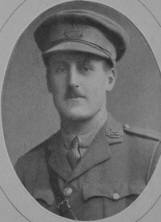
Born: Aspley Guise 1898. Resided: Woburn Sands / Water Hall, Salford. Enlisted: Bedford
Stephen was the son of William and Annie of Water Hall, Salford. He was formerly with the Bedfordshire Regiment, no. 10755. He was killed in action on the western Front, aged 20. He is listed on the Thiennes British Cemetery, Nord, France, and on the Salford Memorial. A descendant of the family knows that he lived all his life in Salford, next to “The Red Lion”, but as with Ernest Cooper, he had given the name of Woburn Sands to the army as his residence.
PRIVATE JOHN (JOSEPH) GRIFFIN, No. 3766 of the Bedfordshire Regiment, 5th Battalion. Died 1st November 1918.
Born: 1889. Resided: 2 Hardwick Place, Woburn Sands.
Joseph was the fifth son of Reuben and Edith Griffin of Aspley Hill. He volunteered August 1914 and was drafted to Mesopotamia the next year. He fought in several battles, before being invalided home with severe dysentery and discharged as unfit for duty in September 1916. He then worked on munitions until he died from the effects of the disease on 1st November 1918, aged 29. He was buried with full military honours at St. Michaels and left a widow, Violet May, and one child living in Hardwick Cottages. Only one J. Griffin appears on the Woburn Sands Memorial, and I believe it refers to John Griffin, who died in combat.
PRIVATE ALFRED HERBERT HARPUR, No. 3/7282 of the Bedfordshire Regiment, 2nd Battalion. Died 17th May 1915.
Born: Cranfield, 12th March 1898. Resided: Woburn Sands. Enlisted: Bedford.
Son of a labourer, William. Alfred was at Festubert with the 2nd Bedfordshires. On May 17th, they withdrew from the front line at 2.30am, but were sent back in at 7.30pm to a different point, and met stiff resistance. By 9pm, the advance had been halted due to heavy casualties and the state of the ground they were trying to cover, which was crossed with trenches full of water. A considerable number of wounded drowned in these trenches. The battalion casualties for this 8 day period of action were: Officers killed 2, wounded 9. Other ranks killed 45, wounded 276, missing 68. This accounted for half the 2nd Bedfordshires strength.
Alfred is listed on the Le Touret Memorial, Pas de Calais, France, the Cranfield Memorial., the Stewartby Memorial and Marston Moretayne Memorial. His name is spelt “Harper” on some indexes.
SERGEANT ARTHUR WILLIAM JOHNSON, No. 205280 of the Royal Bucks Hussars, 1/1st Battalion. Died 13/14th November 1917.
Resided: Woburn Sands. Enlisted: Churn.
Arthur was the son of Captain A. W. and G. Johnson of The Laurels, Silsoe, Ampthill, Bedfordshire. At the outbreak of war, The Royal Bucks Hussars were stationed at Churn. They left in April 1915, and landed at Alexandra, Egypt, two weeks later. From there, “B” and “C” squads went on to Gallipolli unmounted, while “A” squad stayed on the front in Egypt, fighting the Senussi Muslims. “B” and “C” squads returned, and the regiment was refitted.
On the 12th of November, they were camped near Ashdad. The regiment was part of the advance guard of the 6th Mounted Brigade. The entire brigade launched an attack on Mughar Ridge, about 25 miles north east of Gaza, held by 3000 Turkish infantry. The Royal Bucks Hussars had the right flank of 1200 yards. At 3pm they advanced, “B” squad first, then a break of 200 yards, then “C” squad, another 200 yards, then “A” squad.
After 3000 yards at the trot, they charged the enemy. The Turkish infantry broke, but then turned to fight. Dismounted, hand to hand combat followed, before the position was captured. The Turks lost 1200 men, 19 machine guns and 3 artillery pieces. Losses to our side were slight, 5 offices including Major E de Rothschild, and 60 other ranks killed, along with 120 horses. This action is regarded as the last major cavalry charge by the British Army
Arthur appears to have died of wounds sustained in this action, and is listed on the Gaza War Cemetery, Israel.
CHAPLAIN (4TH CLASS) THE REVEREND CECIL LANGDON, MC. Army Chaplains’ Department attached to Border Regiment, 11th Battalion. Died 31st October 1917.
Son of the late Augustin William Langdon, M.A., Barrister-at-Law, Lincoln’s Inn; husband of E. M. Langdon, of Orchard Cottage, Aspley Heath, Woburn Sands, Beds. Incumbent of Horeham Road, Sussex. He was killed in an air raid. Buried at Gwalia Cemetery, Belgium. Aged 35. He has a memorial tablet in St Albans Parish Church, Coombe Road, Brighton, and is also on their War Memorial, as well as Waldron, and Cross In Hand War Memorials, Sussex.
PRIVATE EDGAR MASSEY, No. 23720 of the Bedfordshire Regiment, 4th Battalion. Died 30th October 1917
Born: Broughton 1894. Resided: Woburn Sands (Wilbourn Sands in some indexes!). Enlisted: Ampthill
At the 2nd Battle of Passchendale, the 4th Beds were attacking along a 600 yard front at Paddybeck, to the west of Westroosebeck, along with the Artists Rifles and the 7th Fusileers. It began at 5.50am, but the Germans dropped a counter barrage, 100 yards behind where the Allies bombardment was falling, and caught all the advancing troops out in no-mans land. There were severe casualties due to the bombardment, knee deep mud and sniper fire. Headquarters lost all contact with the front line for 8 hours. At the end of the day, 54 men had been killed, 155 wounded and 23 missing. Francis Tidmarsh was lost in the same action.
Bucks Standard, 24th November, 1917: “Mrs S Massey, Aspley Hill, has also heard officially that her son Pte. Edgar Massey, Beds Rgt. has again been wounded in France. Pte. Massey only returned to the Front after leave 3 weeks ago.” His battalion had been in France since July 1916. He is listed on the Tyne Cot Memorial, Zonnebeke, West Vlaanderen, Belgium.
PRIVATE WALTER EDWARD MOORE, No. 9749, Essex Regiment, 1st Battalion, “B” Company. Died 4th June 1915.
Walters parents lived in Russell Street. They were appealing for news of their son in the local press in November 1914, saying they had last heard from him in July 1914, when his regiment was still in India. According to army records, the 1st Essex were in Mauritius in 1914. They came back to England in December that year, and went out to Alexandra at the end of April 1915.
He was reported as killed in action at the Dardanelles on 4th June 1915. He is listed on the Helles Memorial, Turkey, and on the Aspley Guise Memorial.
PRIVATE GEORGE THOMAS PEACOCK, No. 17427, Bedfordshire Regiment, 7th Battalion. Died 25th April 1918.
Born: Husborne Crawley, 28th January 1891. Resided: Russell Street, Woburn Sands. Enlisted: Bedford/Woburn.
George was the son of Joseph, a labourer and Elizabeth. He was married at St. Michaels in September 1913 to Ellen Butcher. At the time of his first sons baptism, they were living in Mount Pleasant, Aspley Guise, but later they moved to Sandfield Cottages, Weathercock Lane. He was working on the Dukes estate when he enlisted in October 1914, and the 7th Bedfords went to France in July 1915.
He died of wounds on 25th April 1918, leaving three children, Thomas, George and Roland. Listed on the Crouy British Cemetery, Crouy-sur-Somme, France, and on the Woburn War Memorial.
PRIVATE FREDRICK WILLIAM PEPPITT, No. 27951, Royal Fusiliers, “A” Coy. 1st Battalion. Died 2nd February 1917.
Son of Fredrick and Elizabeth Peppitt, of Husborne Crawley, where he was born and lived. Enlisted in Luton. Husband of Mary Peppitt, of Station Road, Woburn Sands, Beds. Aged 26. Buried in Philosophe British Cemetery, Mazingarbe, France.
LIEUTENANT JOHN CECIL BUTLER PRINCE, London Regiment (Queen Victoria’s Rifles) 9th Battalion, attached to London Regiment (Queen’s Westminster Rifles) Died 27th September 1918.
Son of the Rev. J. H. and Mrs. Prince, of The Vicarage, Braunton, Devon. Educated at The Knoll, Woburn Sands and Bradfield College. Born at Exeter. Aged 21. Buried at Sauchy-Cauchy Communal Cemetery Extension, France.
GUNNER HERBERT RICHARDSON, No. 156617, Royal Garrison Artillery, 126th Heavy Battery. Died 22nd June 1918
Born: Thame, Oxon, 1883. Enlisted: St. Pancras, Middlesex.
A Pte. H Richardson of the Beds Regiment had been the best man at the wedding of his brother at St Michaels in August 1917.
On the 4th June, 1918, The “North Bucks Times” reported that Mrs Nellie Richardson had been notified that her husband had been killed in action whilst signalling on the Western front, aged 35. She was living at “Rushmere” Theydon Avenue, the family home of Thomas Bowler, in 1919, when she placed a memoriam advert in the “Woburn Reporter”. However, she was listed as living at 6 Pen Road, Holloway, in army records. She, or her husband, may have been related to the Bowlers.
An H. Richardson is mentioned on the memorial stone to Thomas Bowler in St Michaels churchyard. This however, this gives the month of his death as May. Listed on the Hedauville Communal Cemetery Extension.
CAPTAIN ROBERT EDWARD WATSON SEMPLE, M.C. Royal Horse Artillery / Royal Field Artillery. Died 5th November 1918.
Born: Southampton, 10th August 1896.
Robert was the son of Colonel Sir David Semple, the Director General of the Public Health Department in Egypt, and Ethel May, Lady Semple of Woburn Sands. He was educated at Campbell College, Belfast, and passed out from the Royal Military Academy at Woolwich in November 1914, before joining the Guards Artillery Division and going to France in August 1915. He later joined “Y” Guards Trench Mortar Battery, which he commanded for almost a year. He fought at the Somme, Messines, Cambrai, near Ypres and Arras. His Military Cross was awarded in December 1917 for Gallantry in Action, and he was also later Mentioned in Dispatches.
He was wounded in action on the 22nd of October, with gunshot wounds to the left thigh and right leg. His family was telegrammed on October 29th, to say he was gravely ill, and to make haste to see him at No. 8 General Hospital. He died, aged 22, on the 5th November.
Listed in the St. Sever Cemetery, Rouen, France. He appears in the Diocesan return made for Woburn Sands. See also William David Semple.
SECOND LIEUTENANT WILLIAM DAVID SEMPLE, Kings Royal Rifle Corp., 13th Battalion.Died 29th June 1916.
See Robert Semple for family history.
William was the eldest son of Colonel Sir David. The 13th Kings Royal Rifle Corp were billeted at Great Missenden prior to going to France in July 1915. He died leading an attack on enemy trenches as the grenade officer of his regiment. He was 21.
Listed on the Hannes Camp New Military Cemetery, Pas de Calais, France. Listed in the Diocesan Roll. His army service papers have not survived.
SERJEANT PERCY AUGUSTUS SKINNER, No. 4580, Rifle Brigade, 1st Battalion. Died 13th May 1915.
Son of Frank and Ellen Elizabeth Skinner, of 4, Russell Terrace, Woburn Sands. Born and resided in Bedford, enlisted in Northampton. Aged 22. Appears on Ypres (Menin Gate) Memorial.
PRIVATE EDWARD JOHN TEW, No. 8109 of the Bedfordshire Regiment, 1st Battalion.Died 28th October 1914.
Born: Lidlington, 10th August 1884. Resided: Russell Street, Woburn Sands / Lt. Billington, Leighton Buzzard. Enlisted: Bedford.
Edward was the son of Henry, a bricklayer, and Emma of Billington Crossing, Leighton Buzzard. He was killed in action, aged 30, on the Western Front. The “Woburn Reporter” said he was well known in Woburn Sands, and he is listed under Woburn Sands on the Roll of Honour published in the “North Bucks Times”.
He is listed on the Le Touret Memorial, Pas de Calais, France, and on the Leighton Buzzard Memorial.
PRIVATE ALFRED CYRIL WHITLOCK, No. 29760 of the Machine Gun Corp., Prince Alberts Somerset Light Infantry, 8th Battalion. Died 23rd August 1918.
Born: Woburn Sands, 2nd March 1899. Resided: Woburn Road / Newport Pagnell. Enlisted: Bletchley.
Alfred was the 13th and youngest child of Fred, a bricklayer, and Esther. He worked at Birchmoor Farm. He had to lie about his age when he ran off to join the army. His parents moved from the Woburn Sands area to Newport Pagnell, sometime before December 1916, which is when his father died. His mother lived at 30 Bury Avenue, Newport Pagnell. The Prince Alberts Somerset Light Infantry were billeted in Leighton Buzzard in November 1914, and went to France in September 1915, but Alfred was formerly no. 38533 of the Duke of Cornwalls Light Infantry.
His elder brother, Walter, was told of his death. He was killed in action on the Western front. Listed on the Gommecourt British Cemetery No. 2, Hebuterne, Pas de Calais, France, and appears on Newport Pagnell, along with his bother-in-law, Earnest Craker, who was killed in action the day before Alfred.
PRIVATE WILLIAM ALBERT WILSON, No. 149756 of the Royal Sussex Regiment, 39th Battalion, Machine Gun Corp. Died 5th February 1919.
The 1919 Wavendon Register of Electors has William down as living in Station Road, but still away on active service. He was buried at St. Michaels, Woburn Sands. The church register states: “Bertie William Wilson of Aspley Heath, buried 10th February, aged 29. Certified a burial under the Burial Amendment Act.”
He appears on the Woburn Sands Methodist Memorial, and on Aspley Guise Memorial.
PRIVATE GEORGE YARROW, No. 6792 of the 7th Dragoon Guards (Princess Royal’s), “B” squad. Died 6th May 1916.
Born: Wootton, Bedfordshire, 1886. Resided: Woburn Sands. Enlisted: Norwich
George had worked previously as a tailor in Bedford for Mr O’Dell. He had two elder brothers in the forces, and his sister was the wife of Harry Seabrook, landlord of “The Flying Duck”, in Aspley Heath.
The 7th Dragoon Guards arrived in Marseille in October 1914, attached to the Indian Corps. George wrote to his family in December 1914, saying he had spent two years in Egypt and six in India. He asks for some pipes, envelopes and Sunlight soap, and says: “It is snowing hard here, and by Jove, it’s a bit parky after the climate I have been used to for the last 6 years.” He also says that casualties in his regiment are light, but: “We never know our luck. We must hope for the best and keep smiling.”
He died on the Western front. A local descendant recalls being told by George’s sister that she was called to a military hospital in France where George had been taken ill. She made the journey but arrived just after he had died.
Listed on the Le Treport Military Cemetery, Seine-Maritime, France, and on a Memorial board in Wootton Hall, Bedfordshire.
Other Local Memorials
Several other memorials are situated in the district. In 1919, Bedford County Hospital was looking for premises to be their convalescent home, for patients to recover at, which would free up beds at the actual hospital. They found a large house in Aspley Heath called “Homewood” and bought it in 1919 from the executors of the last owner, Wilson Crewdson. It had been built in 1885 by Frederick Boultbee, possibly for use as a school, but until this time it had only been used as a private residence. They paid £4000 for it, and spent a similar amount converting it to suit their needs for a 20 bed convalescent home. It was opened by the Lord Lieutenant S. Howard Whitbread on August 1st 1920. The original rules stated that patients should only stay for two weeks, but could get permission for another two if they were still unwell. Patients were only allowed out between 2-4pm in the winter, and 2-4pm and 5-7pm in the summer. Visitors were only admitted on Saturdays between 1-4pm. Homewood continued in the same use until it was closed in 1968. The building was later used as a private school named ‘Fernwood’, but this closed in 2013, and it was demolished to make way for new houses in 2015.
The bungalow at 41, Weathercock Lane, bears a plaque which reads:
“To the Glory of God
In memory of our Noble Dead,
Crusaders of St. George
Memorial Homes, No.1.
This home was erected and given to the
totally disabled heroes of the Great War
1914 – 1918
by the loyal and patriotic citizens of
Aspley Guise and Woburn Sands.”
The charity that built the house was the “Crusaders of St George and their Memorial Homes Fund for Totaly Disabled Ex-Service Men”, set up by Annie Macdonnell, widow of William Macdonnell, who had been Chief Paymaster of the British Army. The land was given by Henry Hoare, of Wavendon, and was erected by 1925. Macdonnell Gardens, for ex-Servicemen in Watford, was named in her honour.
Further details of this charity can be found in the book, “Wounded in War they Would Work in Peace“, by Sqn. Ldr. Brian Relf.
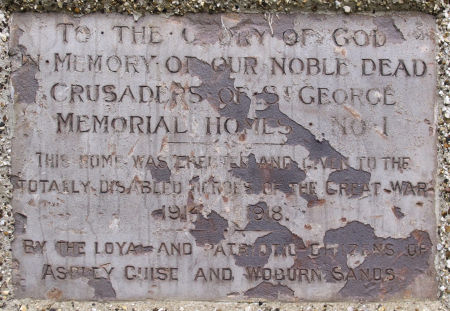
Page last updated Jan. 2019.
